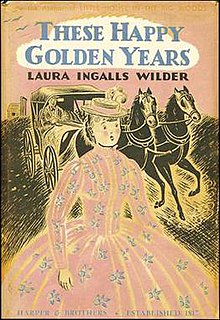This article needs additional citations for verification. (September 2015) |
 Front dust jacket with Sewell's illustration | |
| Author | Laura Ingalls Wilder |
|---|---|
| Illustrator | Helen Sewell and Mildred Boyle[1] Garth Williams (1953)[2] |
| Series | Little House |
| Genre | Children's novel Family saga Western |
| Publisher | Harper & Brothers |
Publication date | March 17, 1943[3] |
| Publication place | United States |
| Media type | Print (hardcover) |
| Pages | 299;[1] 288 pp.[2] |
| OCLC | 2145915 |
| LC Class | PZ7.W6461 Th[1] |
| Preceded by | Little Town on the Prairie |
| Followed by | The First Four Years |
These Happy Golden Years is an autobiographical children's novel written by Laura Ingalls Wilder and published in 1943, the eighth of nine books in her Little House series – although it originally ended it.[1] It is based on her later adolescence near De Smet, South Dakota, featuring her short time as a teacher, beginning at age 15, and her courtship with Almanzo Wilder. It spans the time period from 1882 to 1885, when they marry.
The novel was a Newbery Honor book in 1944, as were the previous four Little House books.[4]
Plot summary
[edit]The novel covers the period in Laura’s life before she marries. At 15, she begins work as a teacher twelve miles away from her home in South Dakota to earn money for her sister Mary’s college education. During her tenure, she boards with the head of the school board and his wife. Almanzo, her neighbor back home, begins driving the twenty-four miles to and from the school so that she can return home on weekends.
After Laura successfully finishes her tenure, Almanzo continues to invite Laura out sleighing once she returns home, beginning their courtship. Laura and Almanzo's romance continues to blossom until he offers her an engagement ring. She accepts his proposal to be married the following summer. When Almanzo tells his family of the engagement, his older sister Eliza Jane plans to throw an elaborate wedding. To stop Eliza Jane from taking over their wedding, Laura agrees to be married quickly. They are married quietly in a small ceremony by the local pastor. The novel ends with them leaving for the little house that Almanzo has built for them.
Historical background
[edit]"Lew Brewster" was a pseudonym for Louis Bouchie. He was a distant relative of Mr. Boast, a good friend of the Ingallses who appears in several of the books. Bouchie and Genevieve Masters were the only two people whose names Wilder changed for her books, as Nellie and Louis Bouchie's wife were both unpleasant people, and she wished to respect their privacy.
Today there is a small town called Carthage, South Dakota, where Wilder placed the Brewster settlement, although it is unclear if Carthage grew out of the original Bouchie (Brewster) settlement.
Nellie Oleson, depicted in this story, is actually a combination of two of Wilder's rivals: Genevieve Masters, in the school passages, and Stella Gilbert, in the passages about the buggy rides with Wilder and Almanzo. The news Wilder hears near the end of the book, that "Nellie has gone back East", refers to Genevieve Masters.
Wilder’s daughter, Rose Wilder Lane, helped write, revise, and publish the Little House series. The extent of Lane's role in her mother's Little House book series has remained unclear.[5]
Themes/Analysis
[edit]Preeminent American literature scholars John Miller and Ann Romines both acknowledge Wilder’s literary talent in articulating feminist western pioneerism. Literary critic Ann Romines argues that These Happy Golden Years received the least amount of revision and oversight from Lane compared to other books in the series, writing that “these are vital female plots without the end-stops of climax and denouement.”[6] She posits that Ma’s character grows in importance throughout the series and becomes especially pertinent in These Happy Golden Years in contrast to Pa’s pioneering impulses. De Smet embodies contrasting masculine and feminine forces that force Laura to balance between earning a living as a teacher while accepting marriage as her fate. Laura’s struggle with her feminine identity implicitly resonates with American girls and women, Romines argues, explaining the book’s continuous appeal.[6]
Reception
[edit]Virginia Kirkus, Wilder's first editor at Harper, approved the novel in Kirkus Reviews as "a splendid addition to the other fine books in the series".[3] The 3rd to 6th volumes had received starred reviews.
The novel joined the 4th to 7th volumes as Newbery Honor Books.[4]
References
[edit]- ^ a b c d
"These happy golden years" (first edition). Library of Congress Online Catalog (catalog.loc.gov). Retrieved 2015-09-18.
Note [quoted]: "The end of the Little house books."–Page at end. - ^ a b "These happy golden years"; Newly illustrated, uniform ed. LC Online Catalog. Retrieved 2015-09-18.
- ^ a b "These Happy Golden Years". Kirkus Reviews. October 1, 1939. Retrieved 2015-10-02. Online the review header shows a recent front cover, gives "volume 4" and "illustrated by Garth Williams".
- ^ a b "Newbery Medal and Honor Books, 1922–Present". Association for Library Service to Children. American Library Association (ALA.org). Retrieved 2015-09-21.
- ^ Maher, Susan Naramore (2000). "Becoming Laura Ingalls Wilder: The Woman behind the Legend, and: Constructing the Little House: Gender, Culture, and Laura Ingalls Wilde (review)". The Lion and the Unicorn. 24 (1): 162–168. doi:10.1353/uni.2000.0006. ISSN 1080-6563. S2CID 143504259.
- ^ a b Romines, Ann (1997). Constructing the Little House: Gender, Culture, and Laura Ingalls Wilder. University of Massachusetts Press. p. 253. ISBN 9781558491229.
External links
[edit]- These Happy Golden Years at Faded Page (Canada)
- Little House Books at HarperCollins Children's Books
- Laura Ingalls Wilder Historic Home & Museum (Official website)